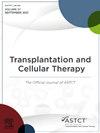血液恶性肿瘤的单输精管细胞移植:多中心扩展准入项目的结果。
IF 3.6
3区 医学
Q2 HEMATOLOGY
引用次数: 0
摘要
omidubicel是fda批准的一种来自脐带血(UCB)的烟酰胺修饰的异基因造血祖细胞疗法。一项3期研究表明,与异体UCB移植相比,欧米dubicel可改善造血功能恢复,减少感染。我们报告了一项扩大准入项目的结果,该项目评估了血液恶性肿瘤患者接受欧米杜比尔移植后的临床结果。在2020年8月至2023年5月期间,29名患者在美国的5个地点进行了移植。患者接受骨髓清除调节,预防性和治疗性药物治疗,以及根据机构指南的支持性护理,并在移植后长达2年的时间内监测移植物、感染和移植物抗宿主病(GVHD)。结果与先前报道的3期结果进行了比较。奥米杜比星接受者的中位年龄为39岁(范围20-73岁,62%为男性);非怀特白血病占45%,急性白血病占65.5%。中位随访时间为11.8个月(范围:0.3 -27.7个月)。中位中性粒细胞和血小板植入时间分别为12天和33.5天。19%的患者在第100天出现急性GVHD(3-4级),9%的患者在第1年出现慢性GVHD,均为轻度。移植后100天出现2 ~ 3级细菌感染的患者占18%,移植后1年出现3级病毒感染的患者占12%。一年无病生存率和总生存率分别为76%和87%。这一现实世界的研究发现,这种移植来源通常用于非白种异体移植受者。奥米杜比星移植后观察到的快速植入动力学似乎已经解决了以前在清髓脐带血移植后观察到的过高的非复发死亡率。本文章由计算机程序翻译,如有差异,请以英文原文为准。
Omidubicel-onlv Transplantation for Hematologic Malignancies: Results of a Multicenter Expanded Access Program
Omidubicel-onlv is an FDA-approved, nicotinamide-modified, allogeneic hematopoietic progenitor cell therapy derived from umbilical cord blood (UCB). A phase 3 study demonstrated improved hematopoietic recovery and decreased infections with omidubicel compared with UCB allogeneic transplantation. We report results of an Expanded Access Program evaluating clinical outcomes in patients with hematologic malignancies following transplantation with omidubicel. Between August 2020 and May 2023, 29 patients were transplanted at 5 US sites. Patients received myeloablative conditioning, prophylactic and therapeutic medications, and supportive care per institutional guidelines, and were monitored for engraftment, infections, and graft-versus-host-disease (GVHD) for up to 2 years post-transplant. Results were compared with previously reported phase 3 outcomes. Omidubicel recipients had a median age of 39 (range 20-73, 62% male); 45% were non-White and 65.5% had acute leukemia. Median follow-up was 11.8 (range: .3-27.7) months. Median neutrophil and platelet engraftment times were 12 and 33.5 days, respectively. Acute GVHD (grade 3-4) at day 100 occurred in 19% of patients, with chronic GVHD at 1 year in 9% of patients, all of which were mild. First grade 2 to 3 bacterial infections through 100 days post-transplant and first grade 3 viral infection 1 year post-transplant occurred in 18% and 12% of patients, respectively. One-year disease-free survival and overall survival rates were 76% and 87%, respectively. This real-world study of omidubicel transplantation for hematologic malignancies finds that this graft source is commonly used for non-White allogeneic transplant recipients. The rapid engraftment kinetics observed following transplantation with omidubicel appears to have addressed excessive nonrelapse mortality that has been previously observed following myeloablative umbilical cord blood transplantation.
求助全文
通过发布文献求助,成功后即可免费获取论文全文。
去求助
来源期刊

Transplantation and Cellular Therapy
Medicine-Hematology
CiteScore
7.00
自引率
15.60%
发文量
1061
审稿时长
51 days
 求助内容:
求助内容: 应助结果提醒方式:
应助结果提醒方式:


